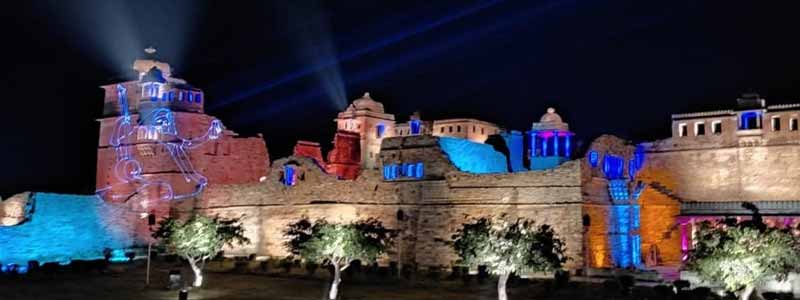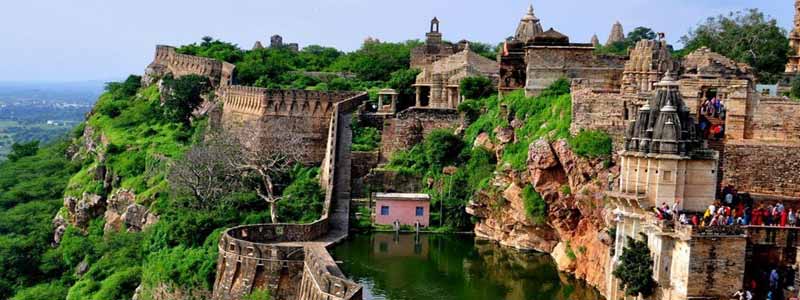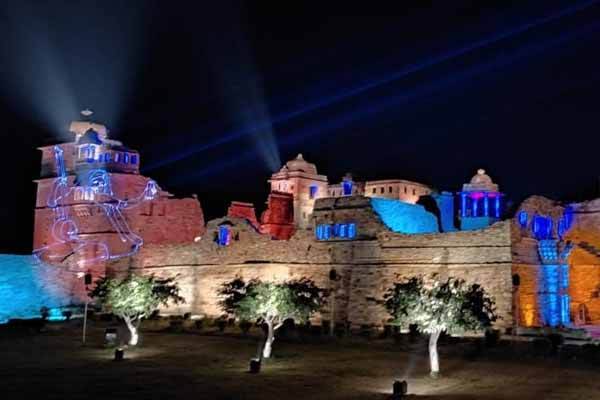Chittorgarh Sound and Light Show is a captivating audio-visual spectacle that takes place at the Chittorgarh Fort, one of the largest forts in India, located in the city of Chittorgarh, Rajasthan. This show is designed to narrate the history and legends associated with the fort and the brave warriors who lived there.
The show typically takes place in the evening, where the fort is illuminated with colorful lights, and the story of Chittorgarh’s rich history is narrated through a combination of sound, lights, music, and visual effects. The narration often includes tales of valor, sacrifice, and the legendary Rajputana heritage that is deeply ingrained in the history of the fort.
The performance usually lasts for about an hour, providing visitors with an immersive experience, showcasing the historical events and legendary tales associated with the fort and its rulers. It’s a popular tourist attraction that offers an engaging way to learn about the heritage and history of Chittorgarh.
Visitors often find the Chittorgarh Sound and Light Show to be a mesmerizing experience that brings history to life through a dynamic combination of technology and storytelling, making the visit to Chittorgarh Fort even more memorable Chittorgarh Tour Packages.

Tips for Visiting Chittor fort, Chittorgarh
This fort in Chittorgarh is one place that you should add to your bucket list if you haven’t already visited it.
- It’s essential to wear comfortable clothes paired with appropriate footwear due to the site’s vast terrain.
- Carrying protective gear such as hats, sunglasses, and sunscreen cannot be overemphasised for protection against sun damage.
- Expect crowds when touring – weekends and holidays are particularly busy. Due to this, it would be wise if you start early by visiting the fort when it opens.
- Bringing ample water supply during the exploration can go a long way in ensuring maximum comfort throughout the tour. While there are shops within the fort’s premises, it’s wise having own provisions with you.
- A local guide is immensely useful when touring this fort since they have detailed information regarding the history, architecture, and significance of each part of the fort.

Nearby tourist spots of Chittor Fort
Chittorgarh, apart from its magnificent fort, offers various nearby tourist attractions that are worth visiting. Some of the notable places near Chittorgarh Fort include:
Rana Kumbha Palace: Located within the Chittorgarh Fort complex, Rana Kumbha Palace is a historic monument known for its impressive architecture and historical significance. It is believed to have been the residence of Maharana Kumbha, the ruler of Mewar.
Vijay Stambh (Victory Tower): A symbol of victory, this towering structure stands tall within the fort complex. Built by Maharana Kumbha to commemorate his victory over Mahmud Khilji, the tower is adorned with intricate carvings and inscriptions.
Kirti Stambh (Tower of Fame): Another remarkable tower within the fort, the Kirti Stambh, represents Jain architecture and is dedicated to Adinath, the first Jain tirthankara. It displays beautiful sculptures and carvings.
Meera Temple: Dedicated to Meera Bai, a prominent devotee of Lord Krishna, this temple is a significant religious site. It holds historical importance and is revered by followers of Meera Bai’s devotion to Lord Krishna.
Kalika Mata Temple: Situated near the fort, this ancient temple is devoted to Goddess Kali. It is known for its religious significance and unique architectural style, Chittorgarh Sound and Light Show.
Padmini Palace: Another palace within the fort complex, it is associated with the legendary tale of Rani Padmini. The palace offers panoramic views of the surrounding areas and a glimpse into the historical events linked to Rani Padmini’s life.
Bassi Wildlife Sanctuary: Located around 25 kilometers from Chittorgarh, this sanctuary is a haven for nature enthusiasts and wildlife lovers. It boasts diverse flora and fauna, including various species of birds and animals.
Exploring these nearby attractions alongside the grandeur of Chittorgarh Tourism visitors a comprehensive insight into the history, culture, and architectural marvels of this region.
Best time to visit Chittor fort
The best time to visit Chittorgarh Fort largely depends on weather conditions and personal preferences, as each season offers a unique experience.
Winter (October to March): This is considered the best time to visit Chittorgarh Fort due to the pleasant weather. The months between October and March experience cool and comfortable temperatures, making it ideal for exploring the fort without being affected by extreme heat. The average temperature during these months ranges from 10°C to 25°C. Clear skies and mild weather allow visitors to explore the fort’s expansive grounds and structures comfortably. Festivals like Diwali and Holi, which fall within this period, add cultural vibrancy to the visit.
Monsoon (July to September): The monsoon season in Chittorgarh brings lush greenery and a refreshing ambiance. However, heavy rainfall can impede outdoor activities, and some parts of the fort might be inaccessible or slippery due to rain. Despite this, the monsoon offers a unique perspective, as the landscape turns vibrant and the surroundings are rejuvenated. The temperature during these months ranges between 25°C and 35°C.
Summer (April to June): Summers in Chittorgarh are scorching hot, with temperatures soaring above 40°C. Visiting the fort during this period can be challenging due to the intense heat, which might make exploration uncomfortable and exhausting. However, if you do visit during these months, it’s advisable to plan your trip in the early morning or late afternoon to avoid the peak heat Chittorgarh Sound and Light Show.
To make the most of your visit to Chittorgarh Fort, the ideal time would be during the winter months (October to March) when the weather is pleasant, allowing for comfortable exploration of the fort’s vast grounds and historical structures. However, if you enjoy the monsoon ambiance and don’t mind occasional rain, visiting during July to September could offer a refreshing and verdant experience despite some limitations due to weather conditions.
How to reach Chittor fort
Chittorgarh Fort, situated in the city of Chittorgarh in Rajasthan, India, is well-connected by various modes of transportation, making it accessible to visitors from different parts of the country. Here’s how you can reach Chittorgarh Fort:
By Air: The nearest airport to Chittorgarh is Maharana Pratap Airport in Udaipur, located approximately 95 kilometers away. From the airport, you can hire a taxi or use public transport like buses to reach Chittorgarh. Udaipur airport is well-connected to major cities in India.
By Train: Chittorgarh has its own railway station, Chittorgarh Junction, which is a major railhead in Rajasthan. It’s well-connected to cities like Delhi, Mumbai, Jaipur, Udaipur, and others through regular trains. From the railway station, you can easily find taxis, auto-rickshaws, or buses to reach the fort.
By Road: Chittorgarh is well-connected by roads to various cities in Rajasthan and neighboring states. National Highway 8 (NH8) and State Highway 9 pass through Chittorgarh. You can reach the fort via private cars, buses, or taxis. Cities like Udaipur (120 km), Jaipur (320 km), and Ajmer (185 km) are connected to Chittorgarh by road Chittorgarh Sound and Light Show.
Local Transportation: Once you reach Chittorgarh, local transportation options like auto-rickshaws, taxis, and buses are available to reach Chittorgarh Fort, which is situated atop a hill. The fort is approximately 5-6 kilometers away from the Chittorgarh city center. Many visitors prefer hiring taxis or autos to reach the fort entrance due to the steep ascent.
It’s advisable to check the schedules of trains or buses in advance, especially during peak tourist seasons, and plan your travel accordingly. Additionally, private transportation or guided tours might also be available from nearby tourist destinations for a more comprehensive visit to Chittorgarh Fort and its historical sites Chittorgarh Sound and Light Show.
